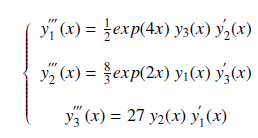A class of single-step hybrid block methods with equally spaced points for general third-order ordinary differential equations
Keywords:
Third-order, Hybrid block method, Convergence, Initial and boundary value problemsAbstract
This study presents a class of single-step, self-starting hybrid block methods for directly solving general third-order ordinary differential equations (ODEs) without reduction to first order equations. The methods are developed through interpolation and collocation at systematically selected evenly spaced nodes with the aim of boosting the accuracy of the methods. The zero stability, consistency and convergence of the algorithms are established. Scalar and systems of linear and nonlinear ODEs are approximated to test the effectiveness of the schemes, and the results obtained are compared against other methods from the literature. Significantly, the study shows that an increase in the number of intra-step points improves the accuracy of the solutions obtained using the proposed methods.

Published
How to Cite
Issue
Section
Copyright (c) 2023 Maduabuchi Gabriel Orakwelu, Olumuyiwa Otegbeye, Hermane Mambili-Mamboundou

This work is licensed under a Creative Commons Attribution 4.0 International License.




